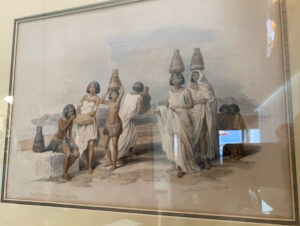 A client owns a series of works dear to my heart. Scottish artist David Roberts (Edinburgh 1796-1864) painted these landscapes in lithographs. During graduate school at the University of Edinburgh, I remember with fondness my former mother-in-law’s eight foot watercolor original of the skyline of Edinburgh by this artist created in the 1830s.
A client owns a series of works dear to my heart. Scottish artist David Roberts (Edinburgh 1796-1864) painted these landscapes in lithographs. During graduate school at the University of Edinburgh, I remember with fondness my former mother-in-law’s eight foot watercolor original of the skyline of Edinburgh by this artist created in the 1830s.
Roberts’s great friend Robert Scott Lauder did a portrait of him in Arab dress, which hangs in the National Portrait gallery of Scotland. Why Arab dress? Well, officials never allow anybody from Europe to paint inside a mosque until the Scottish artist Roberts arrived in 1830. When he requested this honor, they gave him some conditions. They required him to shave off his muttonchop sideburns, leave his hog haired paintbrushes behind, and wear traditional Arab garb. They allowed him to paint many magnificent works marveled on in his day. A challenging aspect to these works today: they’re painted through the eyes of a European. Roberts’s work heralded the new wave of foreign images in Romanticism, and what we now call Orientalism (a pejorative word) in the mid-19th century.
David Roberts Born and Raised in Edinburgh
Scotland’s capital city, the “Athens of the North,” and like its name implies became a center of neo-classism in the 18th and early 19th century. The geometric logic and reasoning in the sciences that accompanied neoclassical art and architecture reflects the famed Scottish proclivity for mechanical design.
Roberts began his career as a painter of Edinburgh and the Highlands. Edinburgh in the early 19th century became the center of the new Romantic movement in Scottish landscape art. When the era of severe neoclassicism waned, the pendulum swung to wildness of landscape, a freedom of brushstrokes, and the expression of emotion in art. The Romantic landscape, composed of seriously dramatic views, became Edinburgh’s contribution to art in the early 19th century. This caused museums and galleries in town to grow.
Edinburgh’s art seemed different from any other art from any other city or country by the 1830s. Previously Edinburgh didn’t have a dedicated patron class of elites to commission art, as did the French and the English. So the Scots artist painted scenes the upper middle-class and wealthy merchant class appreciated, bought, and hung on their walls.
The tenor of the times became a certain atmospheric form of landscape based on JMW Turner, but channeled through the landscape of the Highlands. Once they truly portrayed the Highlands, Scots artists travelled, as did Roberts. After he painted Edinburgh and romantic Scotland, he left for the Holy Land. Scots, like Roberts, have “itchy feet.” Like JMW Turner’s work Roberts studied, his landscape work was strong emotionally, evoked by the sublime landscape rendered in an almost dreamlike mystical form.
Roberts Traveled to the Holy Land in 1838
He depicted the architecture, costumes, and landscapes. Some say Roberts introduced the world to Syria and the Middle East through his art. His friend George Croly’s descriptive words became instrumental in portraying the Arab culture. He completed these works on site as drawings and watercolors of record in a mere eleven months. Roberts carefully composed atmospheric images known for both the sublime scenery and the imposing architecture. Also, conversely, the picturesque: tiny, detailed, humorous images of local color. Perhaps David Roberts’s most famous work is this portfolio of images and words: Views in the Holy Land, Syria, Idumea, Arabia, Egypt, and Nubia, published by F G Moon from 1846-9, called by some critics as one of the greatest travel works ever completed in a series of lithographs.
His work today isn’t as revered as it once was because it’s judged through the eyes of our 21st century. Critics say the depiction of the Eastern or Asian world, or, as they termed it in Roberts” time, the “Oriental” world had, in the mid-19th century been depicted though the eyes of an artist raised in an imperialist tradition. Some critics said Roberts “constructed” how the 19th century looked at the Middle East and “the other.” This post-colonial viewpoint made an effect on the value of Roberts’s work. The value of a lithograph in the series is $1,200 and above.